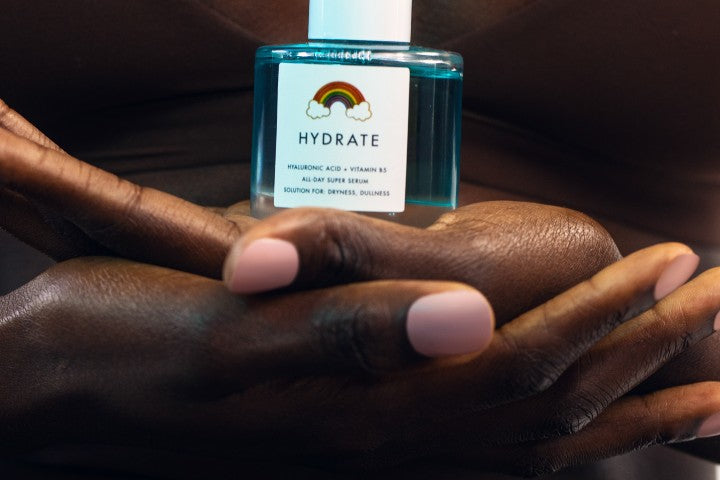How to Treat Peeling Nails

Peeling nails aren't pretty.
Everything from overhydration to vitamin deficiencies to gel manicures can leave your natural nails dry, brittle, and peeling.
Here are some tips for restoring them back to good health.
WHAT CAUSES PEELING NAILS?
Have you got a few minutes? You're going to need it because there are multiple reasons behind nail peeling. Let's take a look at the most common ones.
Gel and Acrylic Nails
Peeling nails can be caused by wearing gel or acrylic nails. These types of nails weaken the nail bed due to the amount of filing, buffing, soaking, and chemicals used. That doesn't mean you need to quit your salon trips altogether, but it does mean giving it some time out -- at least for a couple of weeks so your nails can regain their strength.
Overhydration
Whether from regular handwashing or washing the dishes, your hands are continually exposed to water. All this moisture can lead to weak nails.
In addition to wearing rubber gloves as a preventative measure, try using nail strengthener treatments to help protect your nails from absorbing water. Hand creams with humectants can also help prevent nail dryness and flaking. Or, try a moisture-boosting mask to inject hydration into your dry nails and cuticles, like our Hydrate Mask.
Harsh Chemicals
Everything from the acetone in nail polish remover to the formaldehyde in your cleaning products can irritate and dry out your nails, leading to peeling.
Taking a break from nail polish and wearing gloves when cleaning can make all the difference in preventing nail peeling.
Incorrect Filing
The way you file your nails can significantly impact overall nail health. Filing your nails in different directions or doing it too aggressively can lead to tears in your nails. The same applies to buffing. Buff only in one direction to prevent causing damage to the nail bed, which leads to peeling.
If you don't feel confident in your abilities, book an appointment with a manicurist and watch how they do it. Put it to the practice the next time your nails need some TLC.
Vitamin Deficiencies
If you don't wear fake nails and you always wear gloves when doing house chores, this might be a sign of a vitamin deficiency. However, it would have to be an extreme deficiency in order to see a difference in the appearance of your nails.
Iron deficiency is the most common vitamin deficiency that causes dry, peeling nails. See your doctor if you have any concerns. They'll be able to tell you whether or not you have a vitamin deficiency and prescribe the recommended supplements.
HOW TO REPAIR WEAK, BRITTLE NAILS
For strong, healthy nails, it's important to prioritize nail care. Here's what you can do to fix peeling nails.
Soak Nails in Essential Oil
Massaging oils like olive and coconut into the nails and cuticles locks in moisture and creates a protective barrier to prevent dryness.
Coconut oil boasts antibacterial and anti-fungal properties, while olive oil contains major antioxidants, vitamin E, and essential fatty acids that help protect the nails and seal in moisture.
Pour a few teaspoons of your chosen oil into two small bowls. If you're using coconut, microwave it for a few seconds so that it melts. Then stick your fingers in the bowls and let them soak for 20 minutes.
Apply a Cuticle Oil
For daily hydration, apply cuticle oil to your nail bed and cuticles to keep them strong, shiny and smooth. Try our Hydrate Serum for a dose of hyaluronic acid and vitamin B5 which will drench your nails and cuticles in lasting moisture. Apply it to your toenails too if they're looking a little dry and distressed.
Boost Your Intake of Nail-Strengthening Nutrients
Biotin, iron, calcium, and B vitamins are all essential for preventing and treating peeling, splitting nails.
You'll find these vitamins in foods such as avocado, eggs, cauliflower, milk, lean meats, and whole grains. Alternatively, look for them in a supplement or multivitamin to ensure you're getting enough of these nutrients.
Try a Nail Hardener
Nail hardeners are excellent for treating peeling nails. In addition to supporting the nail, these products are typically nutrient-rich which means they offer up other benefits like strengthening, moisturizing, and protecting.
Look for formulas made with nail-nourishing ingredients such as vitamin E, keratin, and coconut oil. For best results, use it as part of your regular nail care routine to boost nail health and ward off peeling.
WAYS TO MAINTAIN HEALTHY NAILS
Maintaining healthy nails can prevent nail peeling as well as fungus and infections. Dermatologists recommend taking a break from gel and acrylic nail applications until your nails regain their strength.
- Apply hand lotiondaily: prevent dry skin by keeping your hands, nails, and cuticles Opt for a lightweight hand cream and massage it into your digits daily to keep them smooth, strong, and shiny.
- Choose tried-and-tested over trending. Stick to products you know work, instead of trying to stay up to date with trends. You don't want to burden your nails with products that harm instead of heal. Use what you know works.
- Hydrate from the inside. In addition to eating a vitamin-rich diet, make sure you drink plenty of water every day to hydrate your nails and stop them from peeling.
- Stop picking, biting, and peeling. Doing any one of these three things will only make matters worse. Whenever a trace of a frayed nail is peeling, grab your nail file and gently file it away.
- Get checked for deficiencies and health conditions. If you do everything right, but you're still experiencing nail peeling, consult your doctor. You may have a vitamin deficiency or a health condition such as anemia or thyroid Once you're diagnosed, you can receive the appropriate treatment and begin seeing an improvement in your nail health.
Peeling nails can be annoying and unpleasant to look at, but that doesn't mean you have to live with them. Luckily, there are plenty of easy solutions to correcting the problem so you can regain healthy, strong nails.
